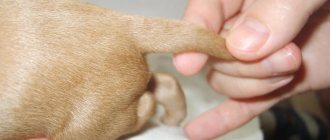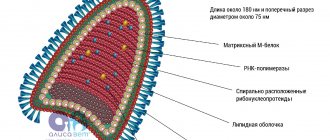The first mention of small Tachichi dogs (presumably the ancestors of the Chihuahua) dates back to the fifth century. Therefore, we can confidently say that this breed has a rich history.
For five centuries (XIV - XIX) babies were on the verge of extinction, but, fortunately, in the 1800s they decided to revive them.
Today, the Chihuahua is one of the most popular dog breeds in the world.
Purebred sneezes are quite expensive. There is no particular need for crossbreeds, so many of us, not wanting to breed crossbreeds (or for other reasons), are asking the question of sterilization and castration.
In our article we will tell you what these procedures are, what their consequences may be, and at what age it is better to have such an operation on a dog.
What are these procedures?
Sterilization and castration are a medical procedure during which an animal is deprived of the ability to reproduce .
Opinions vary regarding the need for this operation.
Some breeders believe that this is a “disfiguring operation that makes a cripple out of an animal” and humans should not interfere with things that nature has designed. Others are guided by the fact that sterilization will reduce the risk of various diseases, and also operate on dogs for reasons of their own comfort.
Below are the advantages of this action:
- life expectancy increases - the dog will live 1.5-2 years longer;
- the pet’s behavior will become more appropriate - aggression towards family members and other dogs will disappear, training will become easier;
- the risk of hormonal diseases and cancer will disappear
IMPORTANT!
Also, at any age, a dog may develop health problems, which may result in the need for sterilization.
There are 3 types of sterilization:
- castration is the removal of the gonads, which entails the cessation of the production of sex hormones. The testes of the cables are cut out, and the ovaries of the bitches;
- sterilization _ For cables, this procedure involves crossing the seed tubes. For females, the procedure is more global - their uterus is cut out;
- chemical castration . The most gentle, because there is no surgical intervention. A special solution is injected into the dog’s withers, which inhibits the dog’s reproductive function. Roughly speaking, the animal loses all thoughts about its offspring. Sexual desire also disappears, so there is no need to worry about changes in behavior during certain periods. By the way, this type of sterilization is reversible. The effect of the drug lasts from 1.5 to 4 years.
The choice of the type of operation remains with the dog's owner.
Castration of a male dog
A surgical procedure to remove both testicles (testes), the paired male gonads, from the scrotum.
Pros:
- blocks male sexual desire, prevents conflicts with potential sexual partners over a female.
- reduces the risk of developing malignant tumors of the prostate gland (prostate) due to the cessation of testosterone production;
- lack of interest in females in heat, so the male stops chasing them;
- balanced and calm behavior;
- a neutered male Chihuahua is easier to socialize and educate, the instinct of dominance is suppressed, and the concentration of attention is increased;
- ceases to relieve hormonal tension on objects and things that, in his opinion, are sexually attractive;
- aggression, as a rule, gives way to friendliness, the animal becomes affectionate and pliable.
Minuses:
- general anesthesia causes more damage to the body than the operation itself;
- the recovery process is slower than after sterilization;
- there may be an increase in appetite, resulting in unwanted excess weight gain. You will have to reconsider your diet to be a little more dietary, but it would be wiser to discuss this issue with your veterinarian.
Is this intervention necessary for a Chihuahua?
There is no need for this operation as such (except when the dog’s health requires it).
For small breeds, sterilization can result in not very good (or rather, very NOT good) consequences in the form of problems with the genitourinary system and a radical change in behavior. And these changes are not always positive.
An advantage of sterilization for owners of female dogs is that the babies stop coming into heat.
In most cases, sterilization has a beneficial effect on the physical and psychological health of the sneeze.
NOTE!
The opinions of various breeders boil down to the fact that if the owner of a Chihuahua does not plan to breed them, then the females must be sterilized to avoid cancer and other terrible diseases.
Regarding the ideal age for surgery on females, the age is 5-6 months (before the first heat). For boys, everything is simpler, because... there are no physiological processes that need to be managed before.
In addition, there is such an unpleasant thing as a false pregnancy. In this situation, the mammary glands of the bitch begin to actively work, but there is no pregnancy itself. This can lead to inflammation of these same glands and their subsequent removal.
The right time for surgery
Before you decide what exactly to do for your Chihuahua - sterilization or castration, you need to carefully consider all the pros and cons. Once any of the operations are done, it will no longer be possible to change anything.
Although surgery can be done at any time, there are some guidelines as to when is the best time to have it done.
It is better to spay or neuter a female Chihuahua before her first heat, that is, at four to six months. A male dog needs to have surgery later, before puberty, at seven to ten months. At such an early age, the likelihood of developing any cancer is minimal.
If you decide to spay or neuter your Chihuahua bitch after giving birth, you need to wait until lactation stops.
There are times when castration is simply necessary. If the disease cannot be cured with medication. For example: orchitis - inflammation of the testicles or injury in the perianal area.
Advantages and disadvantages
For both girls and boys sneezes, the pros and cons of the procedure are almost the same.
The character in most cases becomes more flexible and affectionate. Girls' estrus stops, and boys' desire to mark their territory (including at home) disappears. The reaction to dogs of the opposite sex fades away.
An additional (and perhaps the main) advantage for girls is the elimination of the risk of unplanned pregnancy.
For boys, the period of second childhood begins. They become playful and active again.
The disadvantages include sudden weight gain , possible suppuration of the sutures, lethargy, anesthesia, which in itself negatively affects the cardiovascular system and can also lead to cardiovascular failure.
At what age should I do it?
As mentioned above, the ideal time for sterilization for Chihuahua girls is from 3 to 6 months of age, before the first heat, with the onset of which the gonads begin to produce specific hormones that can (in some cases) provoke the formation of malignant hormone-dependent tumors.
Males can be neutered at any age, but ideally the operation should be done in the first year of life.
IMPORTANT!
Sterilization at a later age becomes dangerous for Chihuahuas, because... there is a risk that the dog will not recover from anesthesia, the heart will fail, or any serious complications will arise.
Sterilization of a male dog
A less invasive surgical method than castration. It consists of ligating or cutting the vas deferens, the connecting link between the testes and the penis, which leads to complete sterility and the inability of the male dog to fertilize. In medical practice, the procedure is called a vasectomy.
Pros:
- minimally invasive procedure compared to castration;
- the operation is performed by a surgeon under local anesthesia together with sedation, which has a more gentle effect on the animal’s body compared to general anesthesia;
- reduces the risk of prostate diseases.
Minuses:
- male hormones continue to be produced, in particular testosterone;
- sexual desire remains, the male continues to pay attention to females;
- the risks of cancerous tumors of the reproductive organs remain;
- the behavior remains the same.
!
Invasiveness means deep interference with the integrity of the internal organs of the biological system of the body.
How to prepare?
Before the operation, it is necessary to fully examine the dog for its health status, take blood and urine tests. Only completely healthy dogs are operated on (to avoid complications). It is also necessary to get all routine vaccinations and get rid of worms.
The owner himself will have to prepare mentally.
The operation lasts on average 20-40 minutes, depending on the type of operation and anesthesia.
For cables, the operation is simpler (lately the testes are removed from the scrotum through a small incision) and will not last long. For bitches, things are more complicated, because in their case a strip operation is performed (whether it is removal of the uterus or ovaries).
Recovery period
The most exciting period will be the first day after surgery.
The dog may wake up immediately, or it may take several hours. In any case, upon arrival home, you need to place your pet on a bedding on a flat surface (ideally, a floor where he cannot fall). The main sign of impending awakening will be twitching of the limbs.
During the action of the anesthetic, all reflexes of the body are turned off, so uncontrolled emptying is likely! Be prepared to change the bedding.
On the first day, food is contraindicated for the baby! Immediately after waking up, you need to wet the dog’s nose with water and offer him something to drink, but you shouldn’t give him a lot of water.
Dangerous signs after surgery may include:
- uneven breathing (both when waking up after anesthesia and while awake);
- rapid pulse;
- blood in urine;
- suppuration of the suture;
- absence of stool and urine for more than a day (especially lack of elimination of minor needs);
- significant increase in temperature
During the rehabilitation period, the breeder has even greater obligations - it is necessary to treat the stitch and give the dog medications. Most often, veterinary clinics provide a list of necessary ointments and preparations along with instructions for treating sutures.
NOTE!
In addition to medications and suture treatment, a change in diet is required after surgery. Nowadays stores are full of a variety of food for sterilized animals, but it is still better to consult a veterinarian on this issue.
Nutrition
Compliance with diet during the rehabilitation period is an extremely important aspect on the path to the full recovery of the four-legged animal. After recovery from anesthesia, the cardiovascular and respiratory systems are the first to return to normal function; the digestive system joins a little later.
A dog is quite capable of starving for 3 days without harm to its body. If you rush and feed your dog ahead of schedule, there is a chance of causing vomiting or, even worse, causing the development of pneumonia due to food particles getting into the lungs, and this is extremely life-threatening.
You can give your dog water when it can stand on its feet normally and can walk. If the dog has not yet recovered from anesthesia, then water is poured into the cheek in small portions. The animal should be fed correctly so that the seam does not come apart during defecation, which can cause constipation. To avoid such unpleasant situations, you should start feeding the dog only when the signs of anesthesia completely disappear.
In the first week, give preference to canned food, mousses, and dry food, which is pre-soaked in water. After a week, you can return to your daily diet, but make the portion 20% less than usual. Dry food is available for sterilized dogs, which should be used to fatten the pet after its recovery. This will help avoid excess weight gain, which often accompanies spayed bitches.











